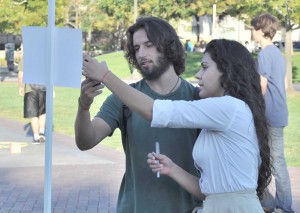Interactive survey uses multimedia experience
The intersection of technology and everyday life was pushed in a new direction Tuesday in McCarthy Quad, as more than 50 students and alumni traversed hula-hoops, iPhones in hand and tough questions around every turn.

Survey says · Mariana Aguilar explains how her “Immersive Life Size Survey” works to Chris Clapis, a sophomore majoring in computer science. - Mindy Curtis | Daily Trojan
As part of her thesis project, Mariana Aguilar, a senior majoring in social sciences with an emphasis in psychology, set up the “Immersive Life Size Survey” on campus to test the impact meshing technology, multimedia literacy and everyday life with surveying real-time experiences.
“People are more comfortable and more interested when technology is involved,” Aguilar said. “Being in a life-size space [with technology] where, depending on how you answered a question, you would move through space differently, you weigh the questions more heavily.”
Aguilar’s project represents recognition of the growing importance real-time multimedia experiences will play in the coming years, according to Holly Willis, a research assistant professor and director of academic programs for the Institute for Multimedia Literacy.
“Technology is increasingly becoming interwoven into everyday life,” Willis said. “People crave being out in the world and connecting with people.”
The project, supported through IML and the School of Cinematic Arts, aims to investigate the differences between survey responses in a physical setting with a multimedia aspect against responses to more traditional computer surveys.
Participants in Tuesday’s survey were presented with three preliminary identification questions and five survey questions. They began the survey at the center hula-hoop and moved outward to the next hoop, depending on each answer.
“I wanted to look at how people make different decisions in different media,” Aguilar said.
Survey participant David Saller, a USC graduate with a bachelor’s degree in history, said he felt the survey was unique in the way it challenged him to weigh his options in a more physical space.
“[The survey] allows you to understand that your response is going to dictate something,” Saller said. “You know that obliquely when you’re taking a survey but after the first question [in a physical setting] you realize whatever you answer is going to effect where you move. It challenges you to be more honest.”
Responses to the five questions, which ranged from simple informational questions to ethical and moral dilemmas, were recorded with the smartphone app “Scan” with Quick Response codes attached to large pegs near each hoop. After completing the survey, the five hoops each participant visited were mapped visually along the route the participant took.
Aguilar said she hopes to determine the effect of combining real-life experiences with multimedia by comparing the maps of the participants in the “life-size” setting against those from survey-takers who answered the same questions at a computer.
According to Aaron Harris, a freshman majoring in mechanical engineering, the experience was far different than simply sitting behind a computer to take a survey.
“It was an interesting way to use new forms of media to tie into old [methods] of gathering data,” Harris said.
Technology and new media crossing into daily life is something Saller expects will define the way people interact with each other in the coming years.
“Interactivity is the way of the future,” Saller said.
This intersection of real-life experiences and multimedia aspects gave Aguilar the chance to attract students to her project, all while exploring the way technology changes students’ everyday lives.
“Technology is, after all, the way to get the attention of our generation,” Aguilar said.
